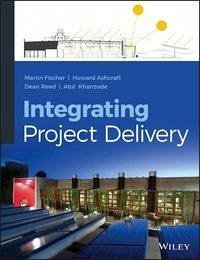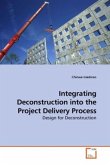- Gebundenes Buch
- Merkliste
- Auf die Merkliste
- Bewerten Bewerten
- Teilen
- Produkt teilen
- Produkterinnerung
- Produkterinnerung
Practical Guidelines for Aligning Project Collaborators for Optimal Delivery Every project can benefit from integration; integration creates synergies that lead to higher performing buildings and happier building users, clients, and project teams. Integrating Project Delivery offers the first comprehensive look at the emergent integrated project delivery (IPD) system. It uses the Simple Framework to organize the essential steps for integration and combines the key structural, process, technology, and behavioral components necessary to drive the behavioral change required to achieve high…mehr
Andere Kunden interessierten sich auch für
![Design Manager's Handbook Design Manager's Handbook]() John EynonDesign Manager's Handbook74,99 €
John EynonDesign Manager's Handbook74,99 €![Integrating Deconstruction into the Project Delivery Process Integrating Deconstruction into the Project Delivery Process]() Chinwe IsiadinsoIntegrating Deconstruction into the Project Delivery Process51,99 €
Chinwe IsiadinsoIntegrating Deconstruction into the Project Delivery Process51,99 €![Managing Measurement Risk in Building and Civil Engineering Managing Measurement Risk in Building and Civil Engineering]() Peter WilliamsManaging Measurement Risk in Building and Civil Engineering71,99 €
Peter WilliamsManaging Measurement Risk in Building and Civil Engineering71,99 €![Corporate Strategy in Construction Corporate Strategy in Construction]() Steven MccabeCorporate Strategy in Construction79,99 €
Steven MccabeCorporate Strategy in Construction79,99 €![Civil Engineer's Handbook of Professional Practice Civil Engineer's Handbook of Professional Practice]() Karen Lee HansenCivil Engineer's Handbook of Professional Practice150,99 €
Karen Lee HansenCivil Engineer's Handbook of Professional Practice150,99 €![An Effective Strategy for Safe Design in Engineering and Construction An Effective Strategy for Safe Design in Engineering and Construction]() David EnglandAn Effective Strategy for Safe Design in Engineering and Construction98,99 €
David EnglandAn Effective Strategy for Safe Design in Engineering and Construction98,99 €![Construction Project Organising Construction Project Organising]() Construction Project Organising129,99 €
Construction Project Organising129,99 €-
-
Practical Guidelines for Aligning Project Collaborators for Optimal Delivery Every project can benefit from integration; integration creates synergies that lead to higher performing buildings and happier building users, clients, and project teams. Integrating Project Delivery offers the first comprehensive look at the emergent integrated project delivery (IPD) system. It uses the Simple Framework to organize the essential steps for integration and combines the key structural, process, technology, and behavioral components necessary to drive the behavioral change required to achieve high performance projects. Detailing the "why" and "how," Integrating Project Delivery helps students and practitioners alike develop a deep understanding of the value of an IPD system to bring stakeholders together early in the planning process to maximize talents and improve project clarity, execution, and, ultimately, success. Written as a guide to using IPD strategically and in daily work, this unique resource includes detailed explanations, discusses legal structures that support the process, and features case studies revealing how leading companies use IPD. You will learn how to change the way your organization works and delivers projects using: * Authoritative education on processes developed through industry-funded research at Stanford University's Center for Integrated Facility Engineering * Practical knowledge gained from all sizes and types of IPD projects * Real-life examples and advice from owners based on their IPD journeys Students learn how collaborative projects are organized and executed to prepare them for the industry transition to collaboration. Owners, designers, and builders learn how to use IPD to achieve better value for all participants, together.
Produktdetails
- Produktdetails
- Verlag: John Wiley & Sons / Wiley
- Seitenzahl: 480
- Erscheinungstermin: 27. März 2017
- Englisch
- Abmessung: 241mm x 197mm x 30mm
- Gewicht: 1000g
- ISBN-13: 9780470587355
- ISBN-10: 0470587350
- Artikelnr.: 36932573
- Herstellerkennzeichnung
- Libri GmbH
- Europaallee 1
- 36244 Bad Hersfeld
- gpsr@libri.de
- Verlag: John Wiley & Sons / Wiley
- Seitenzahl: 480
- Erscheinungstermin: 27. März 2017
- Englisch
- Abmessung: 241mm x 197mm x 30mm
- Gewicht: 1000g
- ISBN-13: 9780470587355
- ISBN-10: 0470587350
- Artikelnr.: 36932573
- Herstellerkennzeichnung
- Libri GmbH
- Europaallee 1
- 36244 Bad Hersfeld
- gpsr@libri.de
MARTIN FISCHER is professor of civil and environmental engineering at Stanford University and serves as the director of the Center for Integrated Facility Engineering (CIFE). HOWARD ASHCRAFT is a Fellow of the American College of Construction Lawyers and the Canadian College of Construction Lawyers (hon.), a member of the AIA California Council (hon.), and an adjunct professor of civil and environmental engineering at Stanford University. DEAN REED is an advocate, organizer and educator for Lean and Integrated Project Delivery at DPR Construction. ATUL KHANZODE is director for Technology and Innovation at DPR Construction, where he assists project teams in implementing Lean Construction and (VDC) Virtual Design and Construction methods.
Foreword xi
By William McDonough, FAIA, Int. FRIBA
Foreword xv
By Phillip G. Bernstein, FAIA, RIBA, LEED® AP, VP Strategic Industry
Relations, Autodesk, Inc.
Preface xix
Acknowledgments xxvii
CHAPTER 1 What Would Make Us Proud? 1
1.1 Current State of Facility Performance 1
1.2 What If? 3
1.3 A Way Forward 5
Notes 9
References 9
CHAPTER 2 Transitioning to Integrated Project Delivery: The Owner's
Experience 11
2.1 The Road to IPD 13
2.2 The Owner's Role 14
2.3 Organizing the Owner 18
2.4 Resistance from Within 19
2.5 Resistance from the AEC Community 20
2.6 Education and Training 21
2.7 The IPD Contract 22
2.8 The Right Level of Challenge 23
2.9 Frustrations 24
2.10 Target Value Design 25
2.11 Reliability 26
2.12 Value 26
2.13 Would You Do It Again? 28
2.14 Advice to Other Owners 28
2.15 Humanity and Morale 29
2.16 Summary 30
Note 30
References 30
CHAPTER 3 A Simple Framework 31
3.1 A Roadmap for Integrating Project Delivery 31
3.2 High-Performance Buildings 33
3.3 Integrated Systems 38
3.4 Process Integration 40
3.5 Integrated Organization 41
3.6 Integrated Information 42
3.7 Connecting the Dots 42
3.8 Applying the Simple Framework 48
3.9 Reflections 51
3.10 Summary 51
Notes 52
References 53
CHAPTER 4 Defining High-Performing Buildings 55
4.1 What Is a High-Performing Building? 55
4.2 What Does Success Look Like? 57
4.3 How Can This Be Done? 59
4.4 Interconnections 67
4.5 Reflections 67
4.6 Summary 69
Reference 69
CHAPTER 5 Achieving Highly Valuable Buildings 71
5.1 What Is a Highly Valuable Building? 71
5.2 What Does Success Look Like? 71
5.3 How Can This Be Done? 72
5.4 Real-Life Examples 89
5.5 Interconnections 92
5.6 Reflections 93
5.7 Summary 94
Note 95
References 95
CHAPTER 6 Integrating the Building's Systems 97
6.1 What Are Integrated Systems? 97
6.2 What Does Success Look Like? 98
6.3 How Can This Be Done? 99
6.4 Real-Life Examples 106
6.5 Interconnections 111
6.6 Reflections 112
6.7 Summary 112
Notes 113
Reference 113
CHAPTER 7 Integrating Process Knowledge 115
7.1 What Is Integrating Process Knowledge? 115
7.2 What Does Success Look Like? 115
7.3 How Can This Be Done? 116
7.4 Real-Life Examples 120
7.5 Interconnections 141
7.6 Reflections 142
7.7 Summary 143
Note 143
References 144
CHAPTER 8 Integrating the Project Organization 145
8.1 Introduction 145
8.2 What Is Integrated Organization? 147
8.3 What Does Success Look Like? 148
8.4 How Can This Be Done? 149
8.5 Real-Life Examples 167
8.6 A Case Study: Integrating the UCSF Medical Center Mission Bay Hospitals
Project 176
8.7 Interconnections 185
8.8 Reflections 186
8.9 Summary 187
Notes 188
References 189
CHAPTER 9 Leading Integrated Project Teams 191
9.1 Introduction 191
9.2 What Are IPD Teams? 192
9.3 What Does Success Look Like? 192
9.4 How Can This Be Done? 193
9.5 Interconnections 206
9.6 Reflections 206
9.7 Summary 206
Notes 206
References 207
CHAPTER 10 Integrating Project Information 209
10.1 Why Bother? 209
10.2 What Is Integrated Information? 210
10.3 What Does Success Look Like? 212
10.4 How Can This Be Done? 215
10.5 Examples and Benefits of Integrated Information Systems 219
10.6 Interconnections 231
10.7 Reflections 232
10.8 Summary 232
Notes 233
References 233
CHAPTER 11 Managing with Metrics 235
11.1 What Are Measurable Value and Control? How Do They Relate? 235
11.2 What Does Success Look Like? 236
11.3 How Does a Project Team Measure and Control the Delivery of Value? 237
11.4 Interconnections 261
11.5 Reflections 262
11.6 Summary 262
Note 262
References 263
CHAPTER 12 Visualizing and Simulating Building Performance 265
12.1 What Are Simulation and Visualization? 265
12.2 What Does Success Look Like? 267
12.3 How Can This Be Done? 269
12.4 Real-Life Examples 285
12.5 Interconnections 290
12.6 Reflections 290
12.7 Summary 291
Notes 292
References 293
CHAPTER 13 Collaborating in an Integrated Project 295
13.1 So What's the Problem? 295
13.2 What Is Collaboration, Really? 296
13.3 What Does Success Look Like? 296
13.4 How Can This Be Done? 297
13.5 Real-Life Examples 309
13.6 Interconnections 313
13.7 Reflections 313
13.8 Summary 314
Notes 314
References 314
CHAPTER 14 Co-locating to Improve Performance 317
14.1 Aspirin for Integration 317
14.2 What Is Co-location, Exactly? 318
14.3 What Does Success Look Like? 318
14.4 How Can This Be Done? 319
14.5 Real-Life Example 329
14.6 Interconnections 333
14.7 Reflections 333
14.8 Summary 333
References 334
CHAPTER 15 Managing Production as an Integrated Team 335
15.1 What Is Integrated Production Management? 335
15.2 What Does Success Look Like? 335
15.3 How Can This Be Done? 336
15.4 Real-Life Example 339
15.5 Interconnections 352
15.6 Reflection 354
15.7 Summary 354
References 355
CHAPTER 16 Avoiding the Pitfalls of Traditional Contracts 357
16.1 Traditional Contracts Create an Inherently Antagonistic Environment
358
16.2 Traditional Contracts Are Based on a Piecework Business Model 358
16.3 Traditional Contracts Rigidly Divide Work Based on Traditional Roles
359
16.4 Traditional Contracts Constrain Communication to Specific and
Inefficient Paths 360
16.5 Traditional Contracts Reward Individual, Not Group, Performance 361
16.6 Collaboration without an IPD Agreement Can Increase Risk 361
16.7 And if Traditional Contracting Is So Successful, How Do We Explain the
Outcomes? 362
16.8 Summary 363
Notes 363
References 364
CHAPTER 17 Contracting for Project Integration 365
17.1 Introduction 365
17.2 Is the IPD Contract Really Necessary? 366
17.3 Deal First, Contract Second 367
17.4 The IPD Contracting Mindset 367
17.5 A New Business Model 369
17.6 A New Contract Structure 371
17.7 Negotiating the IPD Contract 381
17.8 IPD Contract Forms 383
17.9 A Parallel Path: The U.K. Experience 385
17.10 Interconnections 387
17.11 Reflections 388
17.12 Summary 388
Notes 388
References 390
CHAPTER 18 Delivering the High-Performing Building as a Product 391
18.1 What Is the High-Performing Building as a Product? 391
18.2 What Does Success Look Like? 392
18.3 How Can This Be Done? 395
18.4 Real-Life Examples 400
18.5 Summary 432
Notes 433
References 433
Afterword 435
By J. Stuart Eckblad, FAIA, VP Major Construction, UCSF Medical Center
Creating a "Best for Project" Culture 435
Afterword 437
By Eric R. Lamb, Management Committee, DPR Construction Where to Next? 438
Index 439
By William McDonough, FAIA, Int. FRIBA
Foreword xv
By Phillip G. Bernstein, FAIA, RIBA, LEED® AP, VP Strategic Industry
Relations, Autodesk, Inc.
Preface xix
Acknowledgments xxvii
CHAPTER 1 What Would Make Us Proud? 1
1.1 Current State of Facility Performance 1
1.2 What If? 3
1.3 A Way Forward 5
Notes 9
References 9
CHAPTER 2 Transitioning to Integrated Project Delivery: The Owner's
Experience 11
2.1 The Road to IPD 13
2.2 The Owner's Role 14
2.3 Organizing the Owner 18
2.4 Resistance from Within 19
2.5 Resistance from the AEC Community 20
2.6 Education and Training 21
2.7 The IPD Contract 22
2.8 The Right Level of Challenge 23
2.9 Frustrations 24
2.10 Target Value Design 25
2.11 Reliability 26
2.12 Value 26
2.13 Would You Do It Again? 28
2.14 Advice to Other Owners 28
2.15 Humanity and Morale 29
2.16 Summary 30
Note 30
References 30
CHAPTER 3 A Simple Framework 31
3.1 A Roadmap for Integrating Project Delivery 31
3.2 High-Performance Buildings 33
3.3 Integrated Systems 38
3.4 Process Integration 40
3.5 Integrated Organization 41
3.6 Integrated Information 42
3.7 Connecting the Dots 42
3.8 Applying the Simple Framework 48
3.9 Reflections 51
3.10 Summary 51
Notes 52
References 53
CHAPTER 4 Defining High-Performing Buildings 55
4.1 What Is a High-Performing Building? 55
4.2 What Does Success Look Like? 57
4.3 How Can This Be Done? 59
4.4 Interconnections 67
4.5 Reflections 67
4.6 Summary 69
Reference 69
CHAPTER 5 Achieving Highly Valuable Buildings 71
5.1 What Is a Highly Valuable Building? 71
5.2 What Does Success Look Like? 71
5.3 How Can This Be Done? 72
5.4 Real-Life Examples 89
5.5 Interconnections 92
5.6 Reflections 93
5.7 Summary 94
Note 95
References 95
CHAPTER 6 Integrating the Building's Systems 97
6.1 What Are Integrated Systems? 97
6.2 What Does Success Look Like? 98
6.3 How Can This Be Done? 99
6.4 Real-Life Examples 106
6.5 Interconnections 111
6.6 Reflections 112
6.7 Summary 112
Notes 113
Reference 113
CHAPTER 7 Integrating Process Knowledge 115
7.1 What Is Integrating Process Knowledge? 115
7.2 What Does Success Look Like? 115
7.3 How Can This Be Done? 116
7.4 Real-Life Examples 120
7.5 Interconnections 141
7.6 Reflections 142
7.7 Summary 143
Note 143
References 144
CHAPTER 8 Integrating the Project Organization 145
8.1 Introduction 145
8.2 What Is Integrated Organization? 147
8.3 What Does Success Look Like? 148
8.4 How Can This Be Done? 149
8.5 Real-Life Examples 167
8.6 A Case Study: Integrating the UCSF Medical Center Mission Bay Hospitals
Project 176
8.7 Interconnections 185
8.8 Reflections 186
8.9 Summary 187
Notes 188
References 189
CHAPTER 9 Leading Integrated Project Teams 191
9.1 Introduction 191
9.2 What Are IPD Teams? 192
9.3 What Does Success Look Like? 192
9.4 How Can This Be Done? 193
9.5 Interconnections 206
9.6 Reflections 206
9.7 Summary 206
Notes 206
References 207
CHAPTER 10 Integrating Project Information 209
10.1 Why Bother? 209
10.2 What Is Integrated Information? 210
10.3 What Does Success Look Like? 212
10.4 How Can This Be Done? 215
10.5 Examples and Benefits of Integrated Information Systems 219
10.6 Interconnections 231
10.7 Reflections 232
10.8 Summary 232
Notes 233
References 233
CHAPTER 11 Managing with Metrics 235
11.1 What Are Measurable Value and Control? How Do They Relate? 235
11.2 What Does Success Look Like? 236
11.3 How Does a Project Team Measure and Control the Delivery of Value? 237
11.4 Interconnections 261
11.5 Reflections 262
11.6 Summary 262
Note 262
References 263
CHAPTER 12 Visualizing and Simulating Building Performance 265
12.1 What Are Simulation and Visualization? 265
12.2 What Does Success Look Like? 267
12.3 How Can This Be Done? 269
12.4 Real-Life Examples 285
12.5 Interconnections 290
12.6 Reflections 290
12.7 Summary 291
Notes 292
References 293
CHAPTER 13 Collaborating in an Integrated Project 295
13.1 So What's the Problem? 295
13.2 What Is Collaboration, Really? 296
13.3 What Does Success Look Like? 296
13.4 How Can This Be Done? 297
13.5 Real-Life Examples 309
13.6 Interconnections 313
13.7 Reflections 313
13.8 Summary 314
Notes 314
References 314
CHAPTER 14 Co-locating to Improve Performance 317
14.1 Aspirin for Integration 317
14.2 What Is Co-location, Exactly? 318
14.3 What Does Success Look Like? 318
14.4 How Can This Be Done? 319
14.5 Real-Life Example 329
14.6 Interconnections 333
14.7 Reflections 333
14.8 Summary 333
References 334
CHAPTER 15 Managing Production as an Integrated Team 335
15.1 What Is Integrated Production Management? 335
15.2 What Does Success Look Like? 335
15.3 How Can This Be Done? 336
15.4 Real-Life Example 339
15.5 Interconnections 352
15.6 Reflection 354
15.7 Summary 354
References 355
CHAPTER 16 Avoiding the Pitfalls of Traditional Contracts 357
16.1 Traditional Contracts Create an Inherently Antagonistic Environment
358
16.2 Traditional Contracts Are Based on a Piecework Business Model 358
16.3 Traditional Contracts Rigidly Divide Work Based on Traditional Roles
359
16.4 Traditional Contracts Constrain Communication to Specific and
Inefficient Paths 360
16.5 Traditional Contracts Reward Individual, Not Group, Performance 361
16.6 Collaboration without an IPD Agreement Can Increase Risk 361
16.7 And if Traditional Contracting Is So Successful, How Do We Explain the
Outcomes? 362
16.8 Summary 363
Notes 363
References 364
CHAPTER 17 Contracting for Project Integration 365
17.1 Introduction 365
17.2 Is the IPD Contract Really Necessary? 366
17.3 Deal First, Contract Second 367
17.4 The IPD Contracting Mindset 367
17.5 A New Business Model 369
17.6 A New Contract Structure 371
17.7 Negotiating the IPD Contract 381
17.8 IPD Contract Forms 383
17.9 A Parallel Path: The U.K. Experience 385
17.10 Interconnections 387
17.11 Reflections 388
17.12 Summary 388
Notes 388
References 390
CHAPTER 18 Delivering the High-Performing Building as a Product 391
18.1 What Is the High-Performing Building as a Product? 391
18.2 What Does Success Look Like? 392
18.3 How Can This Be Done? 395
18.4 Real-Life Examples 400
18.5 Summary 432
Notes 433
References 433
Afterword 435
By J. Stuart Eckblad, FAIA, VP Major Construction, UCSF Medical Center
Creating a "Best for Project" Culture 435
Afterword 437
By Eric R. Lamb, Management Committee, DPR Construction Where to Next? 438
Index 439
Foreword xi
By William McDonough, FAIA, Int. FRIBA
Foreword xv
By Phillip G. Bernstein, FAIA, RIBA, LEED® AP, VP Strategic Industry
Relations, Autodesk, Inc.
Preface xix
Acknowledgments xxvii
CHAPTER 1 What Would Make Us Proud? 1
1.1 Current State of Facility Performance 1
1.2 What If? 3
1.3 A Way Forward 5
Notes 9
References 9
CHAPTER 2 Transitioning to Integrated Project Delivery: The Owner's
Experience 11
2.1 The Road to IPD 13
2.2 The Owner's Role 14
2.3 Organizing the Owner 18
2.4 Resistance from Within 19
2.5 Resistance from the AEC Community 20
2.6 Education and Training 21
2.7 The IPD Contract 22
2.8 The Right Level of Challenge 23
2.9 Frustrations 24
2.10 Target Value Design 25
2.11 Reliability 26
2.12 Value 26
2.13 Would You Do It Again? 28
2.14 Advice to Other Owners 28
2.15 Humanity and Morale 29
2.16 Summary 30
Note 30
References 30
CHAPTER 3 A Simple Framework 31
3.1 A Roadmap for Integrating Project Delivery 31
3.2 High-Performance Buildings 33
3.3 Integrated Systems 38
3.4 Process Integration 40
3.5 Integrated Organization 41
3.6 Integrated Information 42
3.7 Connecting the Dots 42
3.8 Applying the Simple Framework 48
3.9 Reflections 51
3.10 Summary 51
Notes 52
References 53
CHAPTER 4 Defining High-Performing Buildings 55
4.1 What Is a High-Performing Building? 55
4.2 What Does Success Look Like? 57
4.3 How Can This Be Done? 59
4.4 Interconnections 67
4.5 Reflections 67
4.6 Summary 69
Reference 69
CHAPTER 5 Achieving Highly Valuable Buildings 71
5.1 What Is a Highly Valuable Building? 71
5.2 What Does Success Look Like? 71
5.3 How Can This Be Done? 72
5.4 Real-Life Examples 89
5.5 Interconnections 92
5.6 Reflections 93
5.7 Summary 94
Note 95
References 95
CHAPTER 6 Integrating the Building's Systems 97
6.1 What Are Integrated Systems? 97
6.2 What Does Success Look Like? 98
6.3 How Can This Be Done? 99
6.4 Real-Life Examples 106
6.5 Interconnections 111
6.6 Reflections 112
6.7 Summary 112
Notes 113
Reference 113
CHAPTER 7 Integrating Process Knowledge 115
7.1 What Is Integrating Process Knowledge? 115
7.2 What Does Success Look Like? 115
7.3 How Can This Be Done? 116
7.4 Real-Life Examples 120
7.5 Interconnections 141
7.6 Reflections 142
7.7 Summary 143
Note 143
References 144
CHAPTER 8 Integrating the Project Organization 145
8.1 Introduction 145
8.2 What Is Integrated Organization? 147
8.3 What Does Success Look Like? 148
8.4 How Can This Be Done? 149
8.5 Real-Life Examples 167
8.6 A Case Study: Integrating the UCSF Medical Center Mission Bay Hospitals
Project 176
8.7 Interconnections 185
8.8 Reflections 186
8.9 Summary 187
Notes 188
References 189
CHAPTER 9 Leading Integrated Project Teams 191
9.1 Introduction 191
9.2 What Are IPD Teams? 192
9.3 What Does Success Look Like? 192
9.4 How Can This Be Done? 193
9.5 Interconnections 206
9.6 Reflections 206
9.7 Summary 206
Notes 206
References 207
CHAPTER 10 Integrating Project Information 209
10.1 Why Bother? 209
10.2 What Is Integrated Information? 210
10.3 What Does Success Look Like? 212
10.4 How Can This Be Done? 215
10.5 Examples and Benefits of Integrated Information Systems 219
10.6 Interconnections 231
10.7 Reflections 232
10.8 Summary 232
Notes 233
References 233
CHAPTER 11 Managing with Metrics 235
11.1 What Are Measurable Value and Control? How Do They Relate? 235
11.2 What Does Success Look Like? 236
11.3 How Does a Project Team Measure and Control the Delivery of Value? 237
11.4 Interconnections 261
11.5 Reflections 262
11.6 Summary 262
Note 262
References 263
CHAPTER 12 Visualizing and Simulating Building Performance 265
12.1 What Are Simulation and Visualization? 265
12.2 What Does Success Look Like? 267
12.3 How Can This Be Done? 269
12.4 Real-Life Examples 285
12.5 Interconnections 290
12.6 Reflections 290
12.7 Summary 291
Notes 292
References 293
CHAPTER 13 Collaborating in an Integrated Project 295
13.1 So What's the Problem? 295
13.2 What Is Collaboration, Really? 296
13.3 What Does Success Look Like? 296
13.4 How Can This Be Done? 297
13.5 Real-Life Examples 309
13.6 Interconnections 313
13.7 Reflections 313
13.8 Summary 314
Notes 314
References 314
CHAPTER 14 Co-locating to Improve Performance 317
14.1 Aspirin for Integration 317
14.2 What Is Co-location, Exactly? 318
14.3 What Does Success Look Like? 318
14.4 How Can This Be Done? 319
14.5 Real-Life Example 329
14.6 Interconnections 333
14.7 Reflections 333
14.8 Summary 333
References 334
CHAPTER 15 Managing Production as an Integrated Team 335
15.1 What Is Integrated Production Management? 335
15.2 What Does Success Look Like? 335
15.3 How Can This Be Done? 336
15.4 Real-Life Example 339
15.5 Interconnections 352
15.6 Reflection 354
15.7 Summary 354
References 355
CHAPTER 16 Avoiding the Pitfalls of Traditional Contracts 357
16.1 Traditional Contracts Create an Inherently Antagonistic Environment
358
16.2 Traditional Contracts Are Based on a Piecework Business Model 358
16.3 Traditional Contracts Rigidly Divide Work Based on Traditional Roles
359
16.4 Traditional Contracts Constrain Communication to Specific and
Inefficient Paths 360
16.5 Traditional Contracts Reward Individual, Not Group, Performance 361
16.6 Collaboration without an IPD Agreement Can Increase Risk 361
16.7 And if Traditional Contracting Is So Successful, How Do We Explain the
Outcomes? 362
16.8 Summary 363
Notes 363
References 364
CHAPTER 17 Contracting for Project Integration 365
17.1 Introduction 365
17.2 Is the IPD Contract Really Necessary? 366
17.3 Deal First, Contract Second 367
17.4 The IPD Contracting Mindset 367
17.5 A New Business Model 369
17.6 A New Contract Structure 371
17.7 Negotiating the IPD Contract 381
17.8 IPD Contract Forms 383
17.9 A Parallel Path: The U.K. Experience 385
17.10 Interconnections 387
17.11 Reflections 388
17.12 Summary 388
Notes 388
References 390
CHAPTER 18 Delivering the High-Performing Building as a Product 391
18.1 What Is the High-Performing Building as a Product? 391
18.2 What Does Success Look Like? 392
18.3 How Can This Be Done? 395
18.4 Real-Life Examples 400
18.5 Summary 432
Notes 433
References 433
Afterword 435
By J. Stuart Eckblad, FAIA, VP Major Construction, UCSF Medical Center
Creating a "Best for Project" Culture 435
Afterword 437
By Eric R. Lamb, Management Committee, DPR Construction Where to Next? 438
Index 439
By William McDonough, FAIA, Int. FRIBA
Foreword xv
By Phillip G. Bernstein, FAIA, RIBA, LEED® AP, VP Strategic Industry
Relations, Autodesk, Inc.
Preface xix
Acknowledgments xxvii
CHAPTER 1 What Would Make Us Proud? 1
1.1 Current State of Facility Performance 1
1.2 What If? 3
1.3 A Way Forward 5
Notes 9
References 9
CHAPTER 2 Transitioning to Integrated Project Delivery: The Owner's
Experience 11
2.1 The Road to IPD 13
2.2 The Owner's Role 14
2.3 Organizing the Owner 18
2.4 Resistance from Within 19
2.5 Resistance from the AEC Community 20
2.6 Education and Training 21
2.7 The IPD Contract 22
2.8 The Right Level of Challenge 23
2.9 Frustrations 24
2.10 Target Value Design 25
2.11 Reliability 26
2.12 Value 26
2.13 Would You Do It Again? 28
2.14 Advice to Other Owners 28
2.15 Humanity and Morale 29
2.16 Summary 30
Note 30
References 30
CHAPTER 3 A Simple Framework 31
3.1 A Roadmap for Integrating Project Delivery 31
3.2 High-Performance Buildings 33
3.3 Integrated Systems 38
3.4 Process Integration 40
3.5 Integrated Organization 41
3.6 Integrated Information 42
3.7 Connecting the Dots 42
3.8 Applying the Simple Framework 48
3.9 Reflections 51
3.10 Summary 51
Notes 52
References 53
CHAPTER 4 Defining High-Performing Buildings 55
4.1 What Is a High-Performing Building? 55
4.2 What Does Success Look Like? 57
4.3 How Can This Be Done? 59
4.4 Interconnections 67
4.5 Reflections 67
4.6 Summary 69
Reference 69
CHAPTER 5 Achieving Highly Valuable Buildings 71
5.1 What Is a Highly Valuable Building? 71
5.2 What Does Success Look Like? 71
5.3 How Can This Be Done? 72
5.4 Real-Life Examples 89
5.5 Interconnections 92
5.6 Reflections 93
5.7 Summary 94
Note 95
References 95
CHAPTER 6 Integrating the Building's Systems 97
6.1 What Are Integrated Systems? 97
6.2 What Does Success Look Like? 98
6.3 How Can This Be Done? 99
6.4 Real-Life Examples 106
6.5 Interconnections 111
6.6 Reflections 112
6.7 Summary 112
Notes 113
Reference 113
CHAPTER 7 Integrating Process Knowledge 115
7.1 What Is Integrating Process Knowledge? 115
7.2 What Does Success Look Like? 115
7.3 How Can This Be Done? 116
7.4 Real-Life Examples 120
7.5 Interconnections 141
7.6 Reflections 142
7.7 Summary 143
Note 143
References 144
CHAPTER 8 Integrating the Project Organization 145
8.1 Introduction 145
8.2 What Is Integrated Organization? 147
8.3 What Does Success Look Like? 148
8.4 How Can This Be Done? 149
8.5 Real-Life Examples 167
8.6 A Case Study: Integrating the UCSF Medical Center Mission Bay Hospitals
Project 176
8.7 Interconnections 185
8.8 Reflections 186
8.9 Summary 187
Notes 188
References 189
CHAPTER 9 Leading Integrated Project Teams 191
9.1 Introduction 191
9.2 What Are IPD Teams? 192
9.3 What Does Success Look Like? 192
9.4 How Can This Be Done? 193
9.5 Interconnections 206
9.6 Reflections 206
9.7 Summary 206
Notes 206
References 207
CHAPTER 10 Integrating Project Information 209
10.1 Why Bother? 209
10.2 What Is Integrated Information? 210
10.3 What Does Success Look Like? 212
10.4 How Can This Be Done? 215
10.5 Examples and Benefits of Integrated Information Systems 219
10.6 Interconnections 231
10.7 Reflections 232
10.8 Summary 232
Notes 233
References 233
CHAPTER 11 Managing with Metrics 235
11.1 What Are Measurable Value and Control? How Do They Relate? 235
11.2 What Does Success Look Like? 236
11.3 How Does a Project Team Measure and Control the Delivery of Value? 237
11.4 Interconnections 261
11.5 Reflections 262
11.6 Summary 262
Note 262
References 263
CHAPTER 12 Visualizing and Simulating Building Performance 265
12.1 What Are Simulation and Visualization? 265
12.2 What Does Success Look Like? 267
12.3 How Can This Be Done? 269
12.4 Real-Life Examples 285
12.5 Interconnections 290
12.6 Reflections 290
12.7 Summary 291
Notes 292
References 293
CHAPTER 13 Collaborating in an Integrated Project 295
13.1 So What's the Problem? 295
13.2 What Is Collaboration, Really? 296
13.3 What Does Success Look Like? 296
13.4 How Can This Be Done? 297
13.5 Real-Life Examples 309
13.6 Interconnections 313
13.7 Reflections 313
13.8 Summary 314
Notes 314
References 314
CHAPTER 14 Co-locating to Improve Performance 317
14.1 Aspirin for Integration 317
14.2 What Is Co-location, Exactly? 318
14.3 What Does Success Look Like? 318
14.4 How Can This Be Done? 319
14.5 Real-Life Example 329
14.6 Interconnections 333
14.7 Reflections 333
14.8 Summary 333
References 334
CHAPTER 15 Managing Production as an Integrated Team 335
15.1 What Is Integrated Production Management? 335
15.2 What Does Success Look Like? 335
15.3 How Can This Be Done? 336
15.4 Real-Life Example 339
15.5 Interconnections 352
15.6 Reflection 354
15.7 Summary 354
References 355
CHAPTER 16 Avoiding the Pitfalls of Traditional Contracts 357
16.1 Traditional Contracts Create an Inherently Antagonistic Environment
358
16.2 Traditional Contracts Are Based on a Piecework Business Model 358
16.3 Traditional Contracts Rigidly Divide Work Based on Traditional Roles
359
16.4 Traditional Contracts Constrain Communication to Specific and
Inefficient Paths 360
16.5 Traditional Contracts Reward Individual, Not Group, Performance 361
16.6 Collaboration without an IPD Agreement Can Increase Risk 361
16.7 And if Traditional Contracting Is So Successful, How Do We Explain the
Outcomes? 362
16.8 Summary 363
Notes 363
References 364
CHAPTER 17 Contracting for Project Integration 365
17.1 Introduction 365
17.2 Is the IPD Contract Really Necessary? 366
17.3 Deal First, Contract Second 367
17.4 The IPD Contracting Mindset 367
17.5 A New Business Model 369
17.6 A New Contract Structure 371
17.7 Negotiating the IPD Contract 381
17.8 IPD Contract Forms 383
17.9 A Parallel Path: The U.K. Experience 385
17.10 Interconnections 387
17.11 Reflections 388
17.12 Summary 388
Notes 388
References 390
CHAPTER 18 Delivering the High-Performing Building as a Product 391
18.1 What Is the High-Performing Building as a Product? 391
18.2 What Does Success Look Like? 392
18.3 How Can This Be Done? 395
18.4 Real-Life Examples 400
18.5 Summary 432
Notes 433
References 433
Afterword 435
By J. Stuart Eckblad, FAIA, VP Major Construction, UCSF Medical Center
Creating a "Best for Project" Culture 435
Afterword 437
By Eric R. Lamb, Management Committee, DPR Construction Where to Next? 438
Index 439








